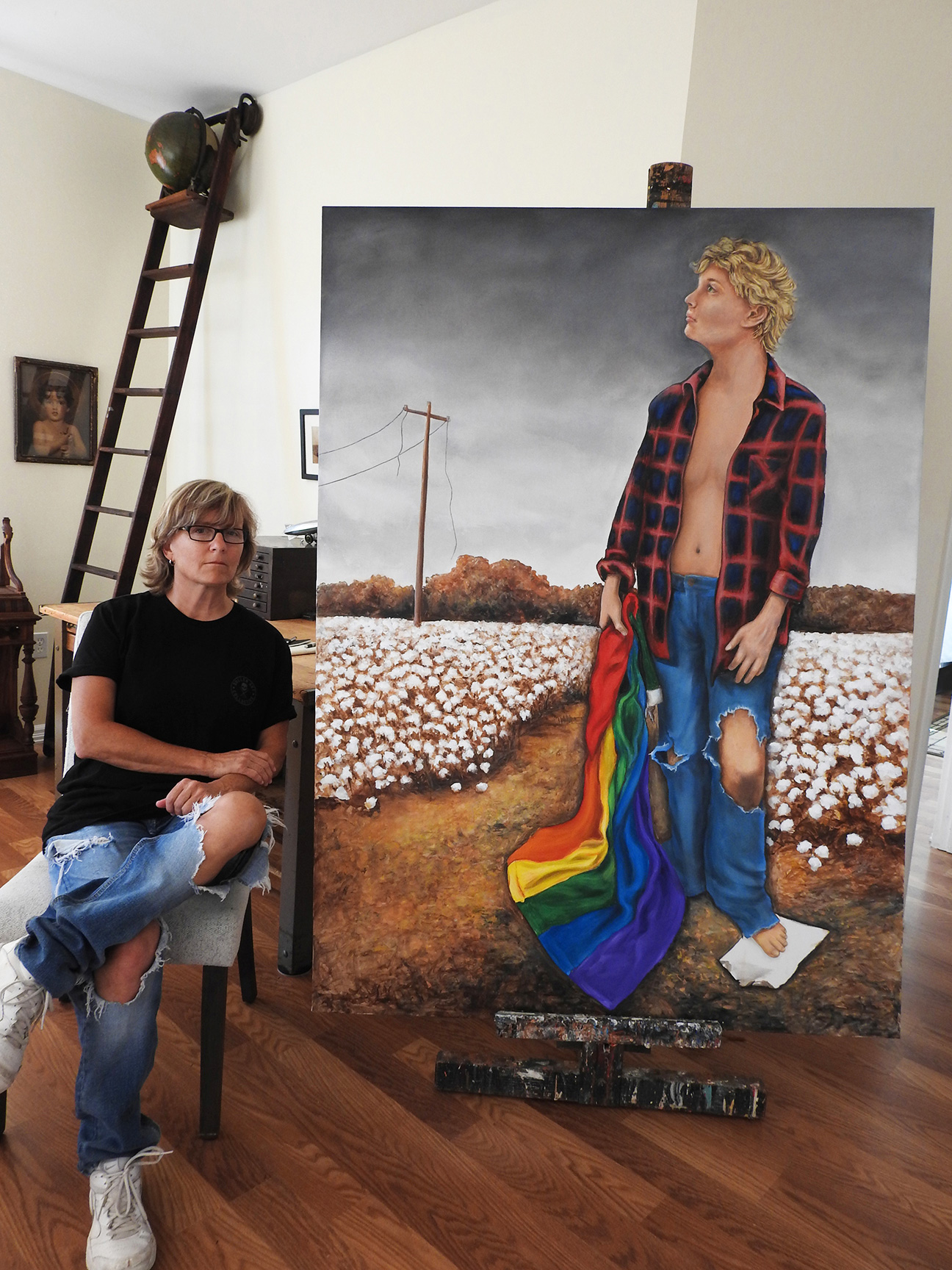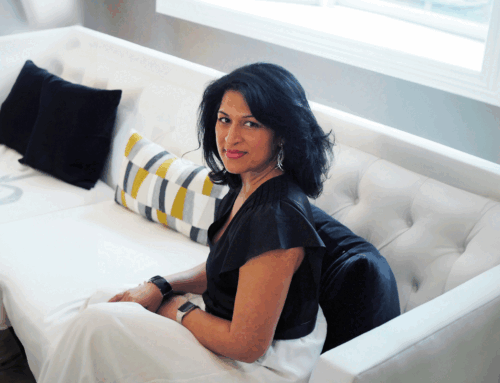Writing by Oscar Andy Hammerstein
Artist V.L. Cox was born in Louisiana and raised in Arkansas. She’s best known for her work surrounding issues of human rights and equality, which has made her both a hero and a villain. In 2021, she left her life in Arkansas, fearing for her future. Today, she lives in Peekskill. Here’s part of her story.
Q: You now live and work in Peekskill, but you grew up in Arkansas. What was your childhood like?
A: It was very bad when I was a kid. My parents split up when I was 10, and my mother had a substance abuse problem – she was an alcoholic and a drug addict. You’d never know it on the outside; she seemed like someone who had it together. But when she drank, she became violent and started wailing on me. I was beaten a lot as a kid. When I was 12, the courts removed me from my mom’s home, and my maternal grandmother got custody.
Q: What attracted you to the world of art?
A: I always wanted to go past my situation – to find another realm. It was my grandmother who encouraged my interest in art. When I was 10, she signed me up for a summer art program at Henderson State University in Arkansas. My grandmother knew that I had issues, you know, with my mother, so it was an outlet, and thank God she promoted that and pushed that.
Q: When did you first become interested in the civil rights movement?
A: I was also raised by a black woman named Queen Victoria, who was one of my grandmother’s best friends. She was wonderful. She taught me about Dr. Martin Luther King Jr. and what the fight for civil rights meant. She was also the mother of Miss Annie Abrams of Little Rock, who is a civil rights activist and a legend down there. I remember when Arkansas schools finally desegregated in ‘68. I remember the first black child in my first grade class. When I invited her to my birthday party, many white parents wouldn’t let their kids attend. I remember all of that. I feel this history is important; it wasn’t that long ago, and what they’re saying now regarding religious freedom and white supremacy is still very much alive.
Q: When did your art become political?
A: I’ve been an artist for over 30 years, and the social justice, political work started in 2015 when the Arkansas State legislature tried to pass one of the first religious freedom bills, and by freedom they meant the freedom to discriminate. Any group that claimed to hold religious beliefs against you could decline to service you, whether it be for a gay marriage, life-saving medical care or even ordering a sandwich in a restaurant while gay. It was terrifying to me. The bill was drafted by ALEC (American Legislative Exchange Council), a very conservative think tank and legislative bill-writing mill. It was also so poorly written that it would have allowed for discrimination against the African American and Jewish communities as well as the LGBTQ+ community.
This injustice inspired me to create THE END HATE DOORS series based on segregation days. I assembled a line of doors – each one labeled with a different group: Whites only. Colored only. LGBT only. Immigrant only. Homeless only. I labeled the last door Human Beings, and it was chained shut to indicate the inhumanity of our divisively cruel way of seeing the world. I lined them up on the steps of the state capitol in protest.
When I woke up the next day, the doors had gone viral, and it definitely changed my career path. I received death threats from a member of the Ku Klux Klan, so I kept a loaded shotgun by the studio door for the next two years and filed an FBI report. But as a result, the Longwood Center for the Visual Arts in Virginia, which has a long history of championing civil rights, offered to tour an exhibition of my art for two years. That was an amazing journey. Most people in the South are really supportive – they got what I was talking about. But I got pushback, too. At the Virginia Holocaust Museum, one piece was destroyed. And in Arkansas, a couple of pieces were censored.
Q: Why were they censored?
A: They were LGBTQ+ religious pieces. But we still had a huge response there. People started questioning their assumptions about segregation, white supremacy, privilege. And that was the reason I did the body of work to begin with.

Q: Does your sexuality inform your work?
A: I do think it does. My work addresses a number of narratives that are personal to me. I led a very privileged life, and I didn’t realize how privileged until 2015, when my rights were being threatened. And that’s as a human being, not just as a woman, not just as LGBTQ+. If you allow someone to take any rights away, then they’re going to come for the rest of your rights eventually. They don’t stop. And it never stops with one group. If you allow one group to be discriminated against, everybody’s gonna get discriminated against. It’s just the way it is. I remember calling Miss Annie and telling her I was scared about the religious freedom bill. She said, “That’s why you’ve got to fight!” And she’s been fighting her whole life. I get it now. As a white woman, I feel I have a responsibility to speak up.
Q: Do you think art can help mend our society?
A: Definitely! An example of the power of art is when authoritarian dictatorships come to power. They crush the arts immediately because art is a way to communicate across religious and political boundaries. I’ve talked with former white supremacists, evangelical ministers, people who vote differently, pray differently, and I found that when I cut through all the blather we’re going through these days, we all are able to engage in meaningful conversations.
When I took the doors to the Lincoln Memorial for the first time, this big skinhead walked up to me. Now, I’ve worked with incarcerated youth a lot; I’ve had gang training, and I knew what his tattoos signified: he was a white supremacist. So he walks up to me and, in a soft voice, says, “I want to thank you for what you’re doing with these doors. I was born into the Klan in south Florida. My father and brother are still in the Klan in south Georgia. My wife and I fled south Georgia under the cover of darkness because my son was transgender and they were going to kill him. They put a hit out on our son, their own flesh and blood. We live in D.C. now, and I’m working on getting my tattoos removed and becoming a man of peace.” We shook hands. He was wearing Buddhist earrings. I’ll never forget that moment. If that man can change his heart after a lifetime of indoctrinated hate, anyone can.
Want to learn more about V.L. Cox? A live, in-depth interview is headed your way soon. Stay tuned for more information.

This article was published in the January/February 2024 edition of Connect to Northern Westchester

Oscar Andy Hammerstein
Oscar Andy Hammerstein is a local artist and writer who has also taught graduate-level NYC theatre history and musical theatre history at Columbia University. He gives frequent lectures on his family’s pivotal role in shaping the development of musical theatre and popular entertainment in this country from the 1860’s to the present.










